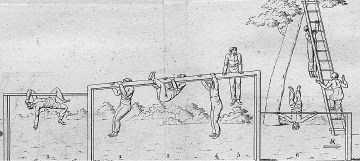1922 The Harvard community is delighted that Leavitt and Peirce, long the unofficial "headquarters for Harvard men," has a new co-owner: Frederick W. Moore, A.B. 1893. Moore and his partner plan to maintain the "gathering place" feel of the store, where undergraduate announcements are posted, tickets to athletic games sold, and billiard balls racked.
In a letter to the editors, a former English concentrator laments Harvard's sparse offerings in contemporary English literature, asserting that students know what they want, and "do not, obviously, want (or need) Anglo-Saxon, or Chaucer, or Bacon, or Puritan Prose."
1927 The editors reproduce excerpts from the hundred-year-old freshman diary of Frederick West Holland, A.B. 1831, including the following: "Received a lesson in Gymnastics from Doctor Follen [see "Vita: Charles Follen"]...on Wednesday he informed mewhat I before knewthat my arms were weak." Holland rushed to purchase a pair of dumbbells.
 |
| Gymnastics practice of the sort popular in Charles Follen's day |
| Harvard College Library (See "Vita") |
1932 Harvard football candidates are now required to change their socks and underwear at least three times a week. Long hair and moustaches, coincidentally, are becoming passé for members of the team.
1937 A smooth-talking sophomore, wearing a business suit and claiming to represent the University's "Heat and Light Department," has visited all the rooms in Holworthy Hall, collecting "radiator rent" from the innocent freshmen; the $3 fee allegedly prevents the removal of their radiators after a five-day grace period.
1942 Football coach Richard Harlow installs a new hitting sack caricaturing Adolf Hitler.

1947 As former vice president Henry Wallace is condemning U.S. foreign policy during a campus speech, a Lampoon member appears on stage, dressed as a bear, in a coonskin coat and fur mittens, and lopes behind Wallace, brandishing a hammer and sickle. The comic is quickly escorted away by the Harvard police.
1952 Officially, only first-years may attend the Harvard-Radcliffe Freshman Orientation Dance, but, the editors report, "almost every able-bodied Harvard man in Cambridge shows up....[Illegal sophomores are] shocked to see their former section men peering over the crowded floor, trying to get a better look at the girl in the blue sweater."
1957 A statistician for the $82.5-million Program for Harvard College campaign has compiled interesting University expenditures, including, under "housekeeping," the purchase of "20,000 rats, 8,000 one-day-old cockerels, and 2,500 rabbits."
1962 During half-time at the Holy Cross game, a mock "officer" chases a young woman on a bicycle across the football field, reminding students that Cambridge police had scoured Harvard Square a week earlier, trucking away any bicycles found on the sidewalk.
1967 Academic options for undergraduates have broadened with the addition of courses in Canadian, Dutch, and Indo-Muslim civilizations. Classes on Africa and Latin America are also available as freshman seminars.
1972 Students returning to campus find the construction of the $19-million science center, the costliest building to date in Harvard history, well under way. "Good grief," the editors pronounce, in view of the enormous spider-like central structure with its nine steel legs, "could this be the palace of some gigantic arachnid, bent on devouring our College?"
1977 Construction begins on the Kennedy School's new $12-million building. The structure, across from Eliot House, "won't mar the skyline," architects promise, and will house a 50,000-volume library, classrooms, offices, and a 500-seat forum that becomes a lecture hall for distinguished visitors.
1982 In a letter to the editor, Michael Hilton '68 rejects other readers' complaints about Harvard's efforts to rid the campus of ivy: "Somebody is convinced that ivy ruins the mortar," he writes, "and it costs $50 grand a year to trim it...if I had $50,000 to spare, I'd send it today, and designate it to trim the ivy....We ought to...plow it all under and make a parking lot out of it. Parking lots are extremely easy to maintain."
1987 "Ambitious plans are afoot to wire the University for the information age," the editors report. The Corporation has been asked to authorize a new Harvard network that will introduce, among other things, "state-of-the-art telephone service."





